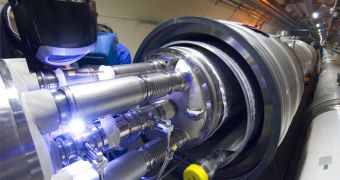What is the dark matter? I don't know; in fact, nobody knows for certain what it is. However, we do know two basic facts: we proved that it does exist, and without it the galaxies would mostly fall apart. Nevertheless, it is extremely hard to create a complete image of the past and future of the universe, when you do not know exactly how heavy it is and its current rough mass distribution.
Physicists have tried in vain to find out what the dark matter is made of. But there is a good chance that it may be composed of elementary particle already known to us. The Large Hadron Collider, which will start the primary tests this year, could provide with new models of universe inflation, in order to account for the missing matter. At the same time, the LHC will try to solve one of the most puzzling questions in the quantum physics field: what is the mass of the neutrino and what role does it take into the inflation models?
Neutrinos were the first particles ever to be proposed as constituents of the dark matter, and still are today. Why neutrinos, you might ask. Well, neutrinos are the particles with the weakest interactions towards the normal matter, so the right-handed supersymmetric neutrinos and sneutrinos are considered to be a form of dark matter.
This means that by finding the mass of the neutrinos, we might be able to exactly determine the total mass of dark matter present in the universe and construct an accurate model of the universe's future destiny, and maybe its true origins.
It is currently believed that the inflation of the universe could be determined by the so-called inflaton particles. However, the physicists found that the inflatons cannot exist except in an interaction between two separate particles, due to the fact that the theoretical models of the inflatons predict that they have integer spin. Indeed, while modeling a sneutron coupled with a supersymmetric lepton particle in order to obtain an inflaton, the experimental limitations were constrained in the predicted ranges.
All that remains now is to test the theory in real life experiments. The observation of supersymmetry in neutrinos would reveal that, indeed, they can be held responsible for the existence of dark matter. The new model presented by the physicists would probably be tested by the end of the year, using the LHC particle accelerator.

 14 DAY TRIAL //
14 DAY TRIAL //